Whispering Gallery Mode Resonators for Precision Temperature Metrology Applications
Abstract
:1. Introduction
- f0 is the resonance frequency;
- T is the temperature;
- ε⏊ and ε‖ are the sapphire permittivity in the radial and axial direction respectively;
- L is the sapphire disk height;
- a is the disk diameter.
2. Materials and Methods
2.1. Sapphire Whispering Gallery Mode Resonator
2.2. Computer Simulations
2.3. Measurement Setup
3. Results
3.1. SWGT Calibration
3.2. Stability and Repeatability at the Ice Melting Point
3.3. Uncertainty Budget Analysis
4. Discussion and Conclusions
Author Contributions
Funding
Institutional Review Board Statement
Informed Consent Statement
Data Availability Statement
Conflicts of Interest
References
- Hallil, H.; Menini, P.; Aubert, H. New microwave gas detector using dielectric resonator based on a whispering-gallery-mode. In Proceedings of the 2009 European Microwave Conference (EuMC), Rome, Italy, 28 September–2 October 2009; pp. 1097–1100. [Google Scholar] [CrossRef]
- Lemieux-Leduc, C.; Guertin, R.; Bianki, M.; Peter, Y. Gas Sensing with SU-8 Whispering Gallery Mode Resonators. In Proceedings of the 2018 International Conference on Optical MEMS and Nanophotonics (OMN), Lausanne, Switzerland, 29 July–2 August 2018; pp. 1–2. [Google Scholar] [CrossRef]
- Righini, G.; Soria, S. Biosensing by WGM Microspherical Resonators. Sensors 2016, 16, 905. [Google Scholar] [CrossRef] [PubMed] [Green Version]
- Reynolds, T.; Henderson, M.R.; François, A.; Riesen, N.; Hall, J.M.M.; Afshar, S.V.; Nicholls, S.J.; Monro, T.M. Optimization of whispering gallery resonator design for biosensing applications. Opt. Express 2015, 23, 17067–17076. [Google Scholar] [CrossRef] [PubMed]
- Pongruengkiat, W.; Pechprasarn, S. Whispering-Gallery Mode Resonators for Detecting Cancer. Sensors 2017, 17, 2095. [Google Scholar] [CrossRef] [PubMed] [Green Version]
- Gavartin, E.; Verlot, P.; Kippenberg, T.J. A hybrid on-chip optomechanical transducer for ultrasensitive force measurements. Nat. Nanotech 2012, 7, 509–514. [Google Scholar] [CrossRef] [PubMed] [Green Version]
- Weigel, T.; Esen, C.; Schweiger, G.; Ostendorf, A. Whispering gallery mode pressure sensing. In Optical Sensing and Detection II; International Society for Optics and Photonics; Proceedings Volume 8439; SPIE Photonics Europe: Brussels, Belgium, 2012. [Google Scholar]
- Foreman, M.R.; Swaim, J.D.; Vollmer, F. Whispering gallery mode sensors. Adv. Opt. Photon. 2015, 7, 168–240. [Google Scholar] [CrossRef] [PubMed]
- Strouse, G.F. Sapphire whispering gallery thermometer. Int. J. Thermophys. 2007, 28, 1812–1821. [Google Scholar] [CrossRef]
- Tobar, M.E.; Krupka, J.; Ivanov, E.N.; Woode, R.A. Dielectric frequency-temperature-compensated microwave whispering-gallery-mode resonators. J. Phys. D Appl. Phys. 1997. [Google Scholar] [CrossRef]
- Yu, L.; Fernicola, V. Spherical-sapphire-based whispering gallery mode resonator thermometer. Rev. Sci. Instrum. 2012, 83, 2–7. [Google Scholar] [CrossRef] [PubMed]
- Shelby, R.; Fontanella, J.; Andeen, C. The low temperature electrical properties of some anisotropic crystals. J. Phys. Chem. Solids 1980. [Google Scholar] [CrossRef]
- Corbellini, S.; Ramella, C.; Yu, L.; Pirola, M.; Fernicola, V. Whispering gallery mode thermometry. Sensors 2016, 16, 1814. [Google Scholar] [CrossRef] [PubMed] [Green Version]
- Rabi, G.J.D.; Wang, T. Progress on 10 Kelvin cryo-cooled sapphire oscillator. In Proceedings of the 2004 IEEE International Frequency Control Symposium and Exposition, Montréal, QC, Canada, 23–27 August 2004; pp. 752–756. [Google Scholar] [CrossRef]
- Ramella, C.; Corbellini, S.; Pirola, M.; Yu, L.; Fernicola, V.C. Investigations on instability effects in a sapphire-based whispering gallery mode thermometer. In Proceedings of the 2017 IEEE International Instrumentation and Measurement Technology Conference, Turin, Italy, 22–25 May 2017. [Google Scholar] [CrossRef]
- Military Specification. Optical Components for Fire Control Instruments; General Specification Governing the Manufacture, Assembly, and Inspection of. MIL-PRF-13830B. 1997. Available online: https://elsmar.com/pdf_files/Military%20Standards/MIL-13830A.pdf (accessed on 5 March 2021).
- Yu, L.; Fernicola, V. Thermometry Based on Whispering Gallery Mode Resonators. Ph.D. Thesis, Politecnico di Torino, Torino, Italy, 2012. [Google Scholar]
- Yu, L.; Fernicola, V. Investigation of sapphire-based whispering-gallery mode resonators as transfer standard thermometers. Meas. Sci. Technol. 2013, 24, 055106. [Google Scholar] [CrossRef]
- Yu, L.; Fernicola, V. A temperature sensor based on a whispering gallery mode resonator. AIP Conf. Proc. 2013, 1552, 920–924. [Google Scholar] [CrossRef]
- Yu, L.; Zhang, G.; Fernicola, V.; Lu, J. Investigations on perturbations of microwave dielectric resonator thermometer. Meas. Sci. Technol. 2017, 28, 047001. [Google Scholar] [CrossRef]
- Quan, H.; Guo, Z. Analytical Solution of Whispering-Gallery Modes. In Proceedings of the ASME 2007 InterPACK Conference, Vancouver, BC, Canada, 8–12 July 2007; pp. 489–497. [Google Scholar] [CrossRef]
- Krupka, J.; Derzakowski, K.; Tobar, M.; Hartnett, J.; Geyer, R.G. Complex permittivity of some ultra low loss dielectric crystals at cryogenic temperatures. Meas. Sci. Technol. 1999. [Google Scholar] [CrossRef]
- Petersan, P.J.; Anlage, S.M. Measurement of resonant frequency and quality factor of microwave resonators: Comparison of methods. J. Appl. Phys. 1998, 84, 3392–3402. [Google Scholar] [CrossRef] [Green Version]
- Robinson, M.P.; Clegg, J. Improved Determination of Q-Factor and Resonant Frequency by a Quadratic Curve-Fitting Method. IEEE Trans. Electromagn. Compat. 2005, 47, 399–402. [Google Scholar] [CrossRef]
- Gugliandolo, G.; Aloisio, D.; Campobello, G.; Crupi, G.; Donato, N. Development and metrological evaluation of a microstrip resonator for gas sensing applications. In Proceedings of the 24th IMEKO TC-4 International Symposium, Palermo, Italy, 14–16 September 2020; pp. 1–4. [Google Scholar]
- Mehl, J.B. Analysis of resonance standing-wave measurements. J. Acoust. Soc. Am. 1978, 64, 1523–1525. [Google Scholar] [CrossRef]
- Kenneth, H.D.; Steele, A.G. The Non‐Uniqueness of the ITS‐90: 13.8033 K to 273.16 K. In AIP Conference Proceedings; AIP Publishing: Melville, NY, USA, 2003; Volume 684, No. 1. [Google Scholar]
- Saunders, P. The non-uniqueness of ITS-90 above the silver point and its impact on values of T–T 90. Metrologia 2020, 57, 045007. [Google Scholar] [CrossRef]
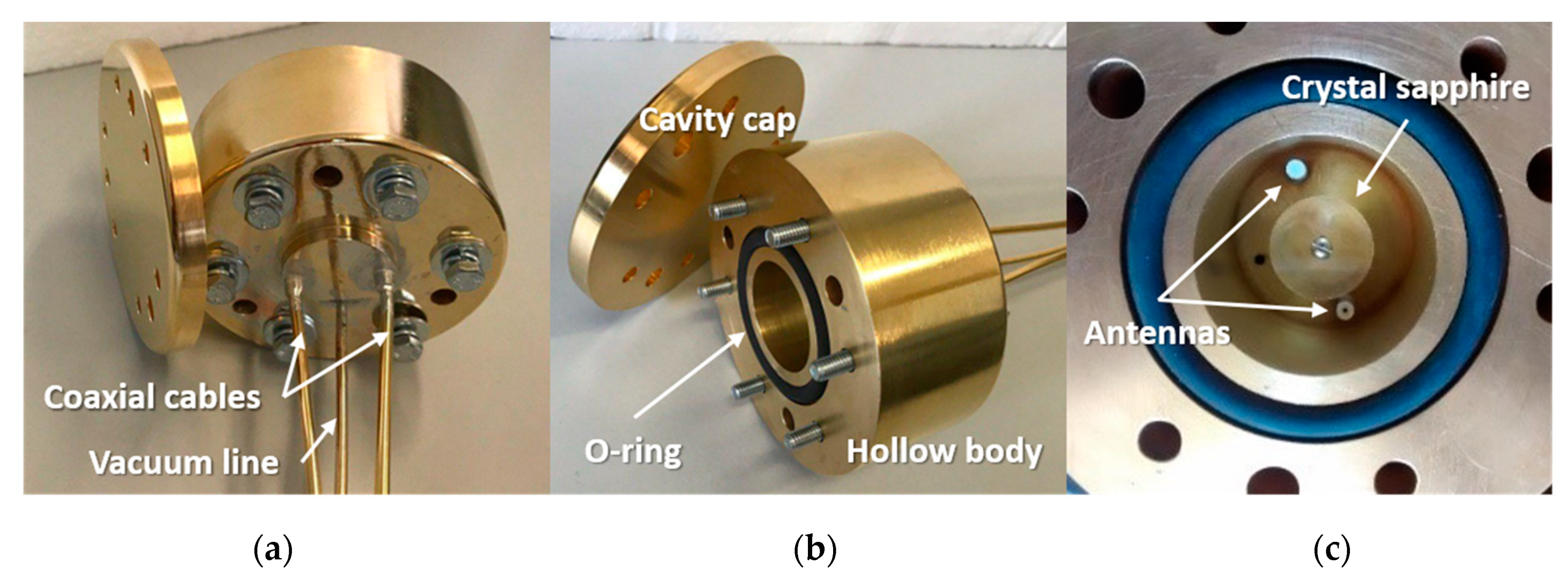
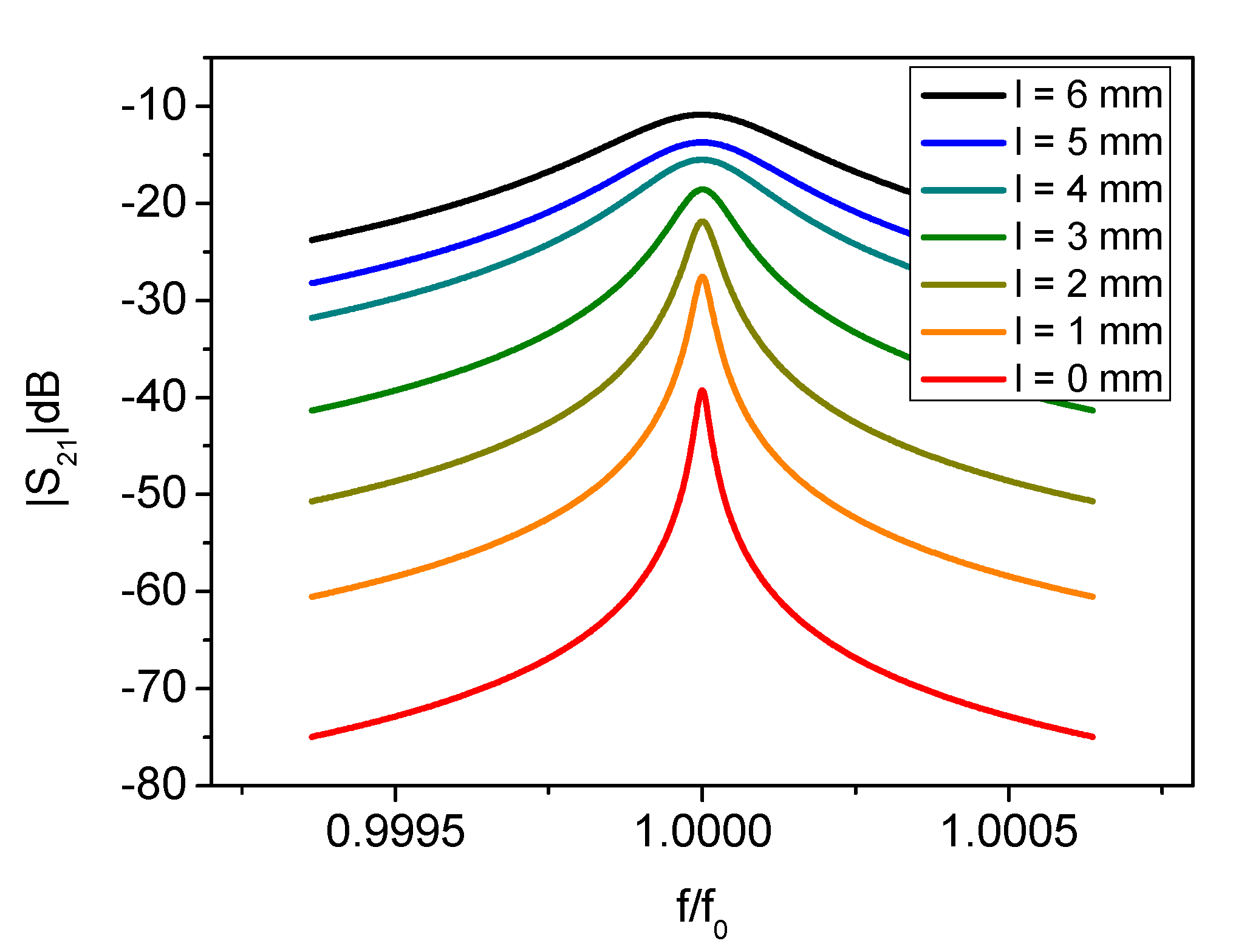
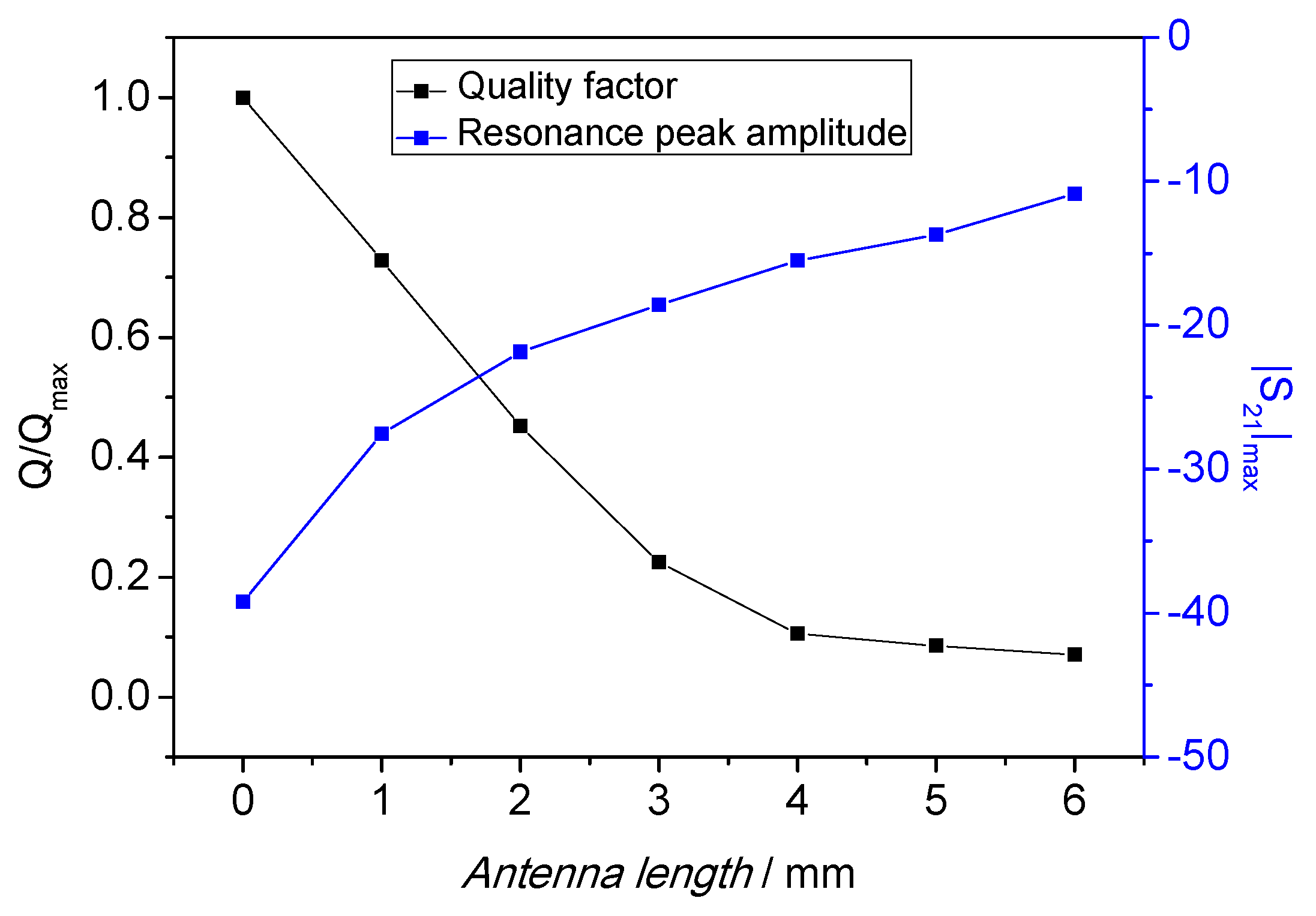

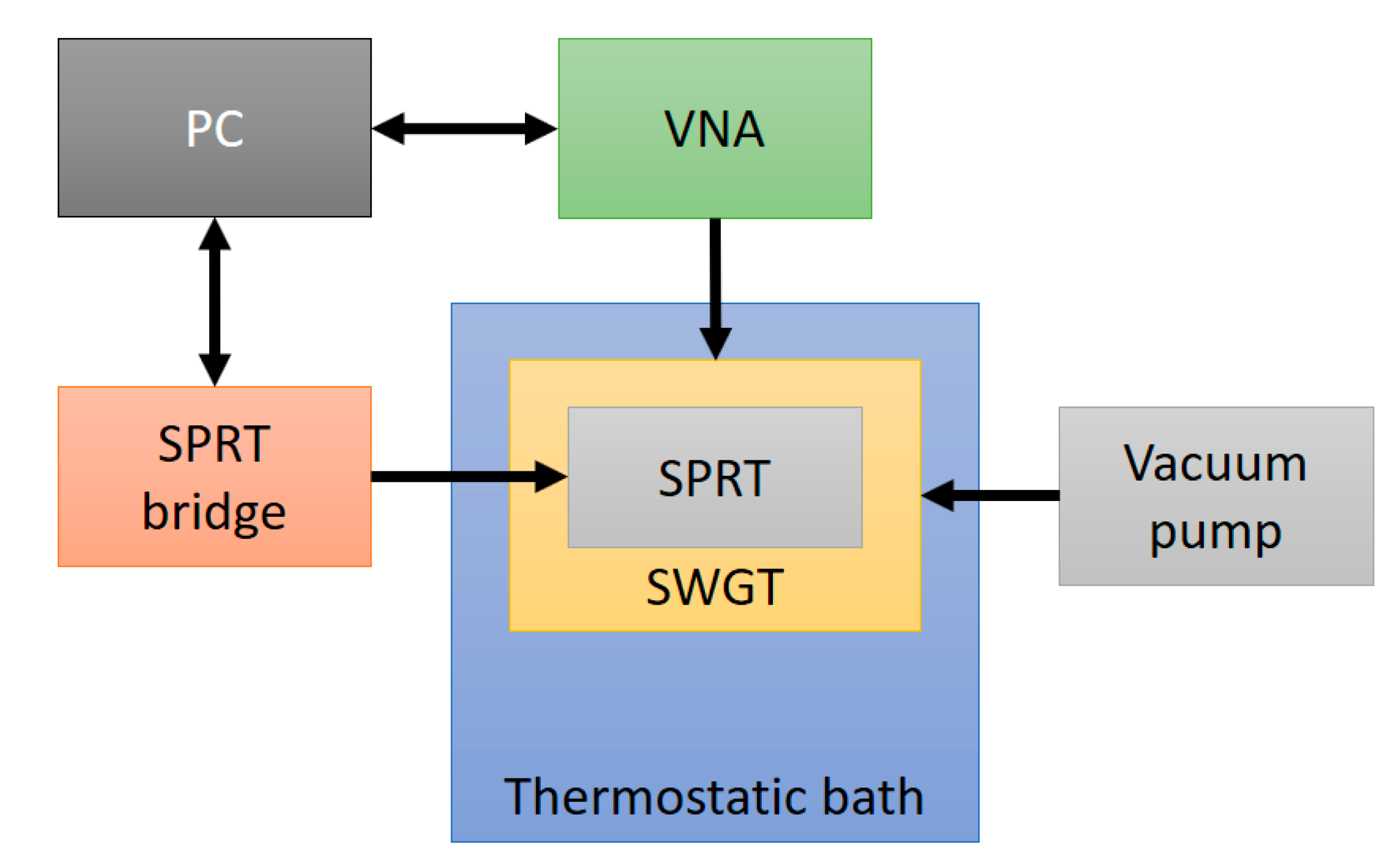
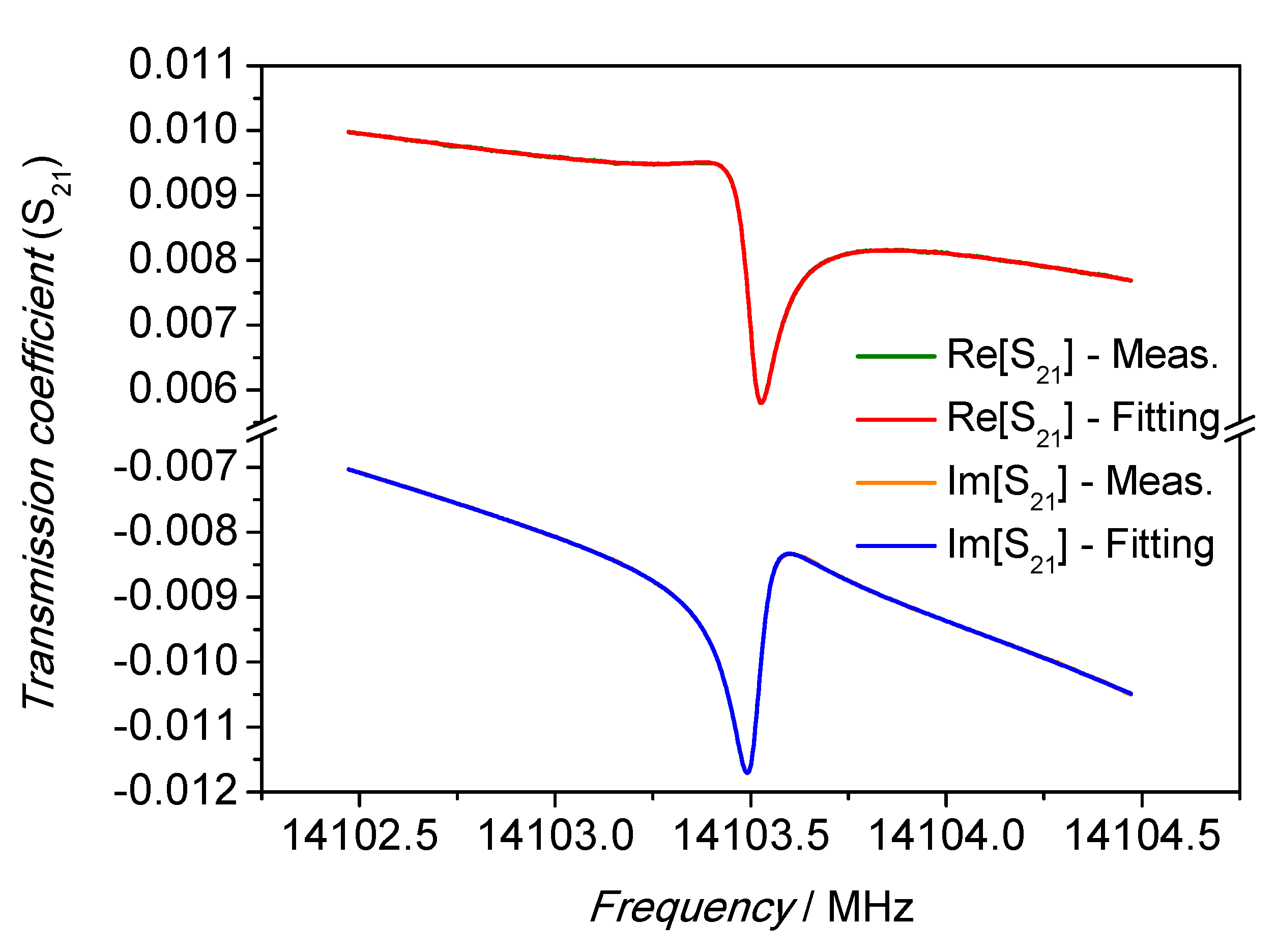
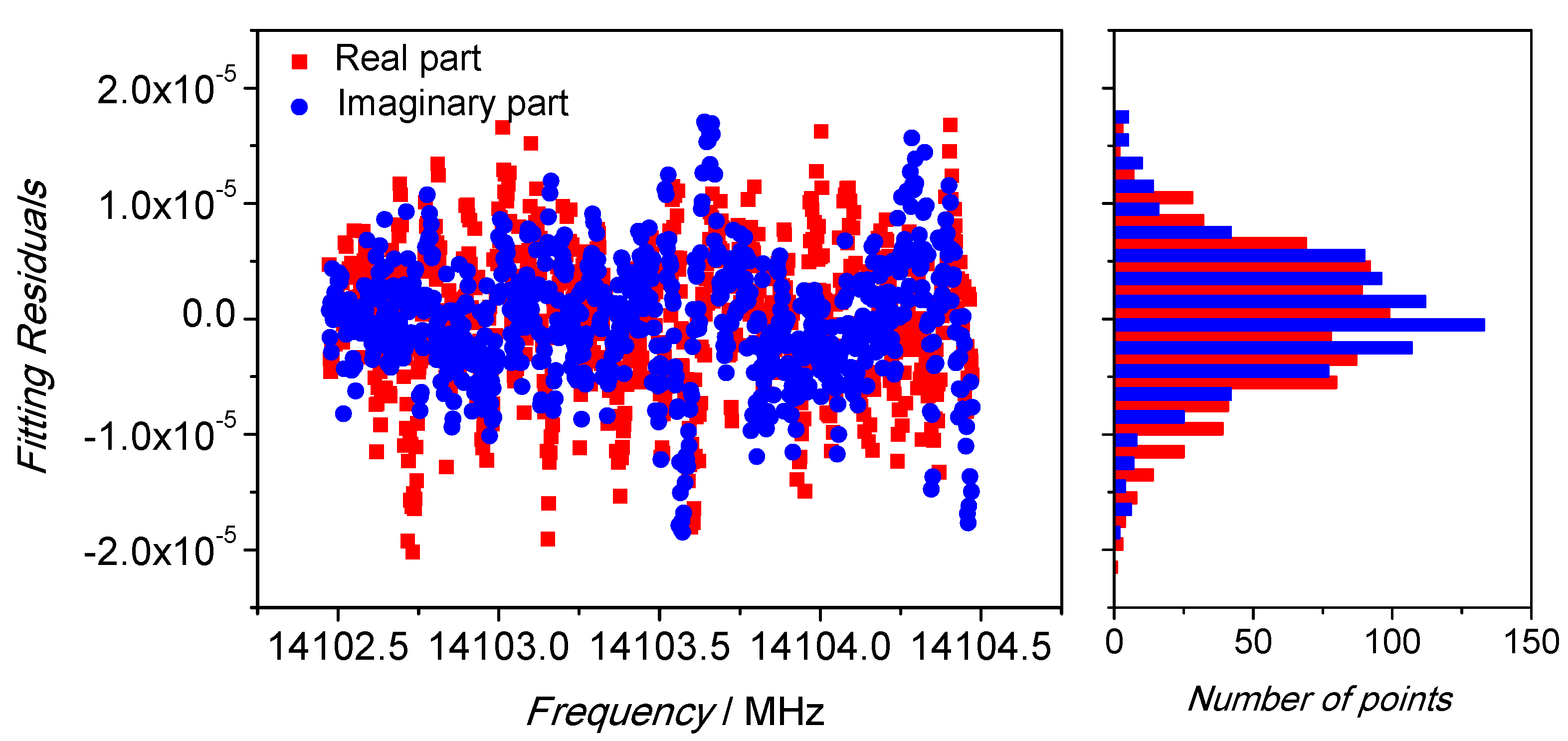
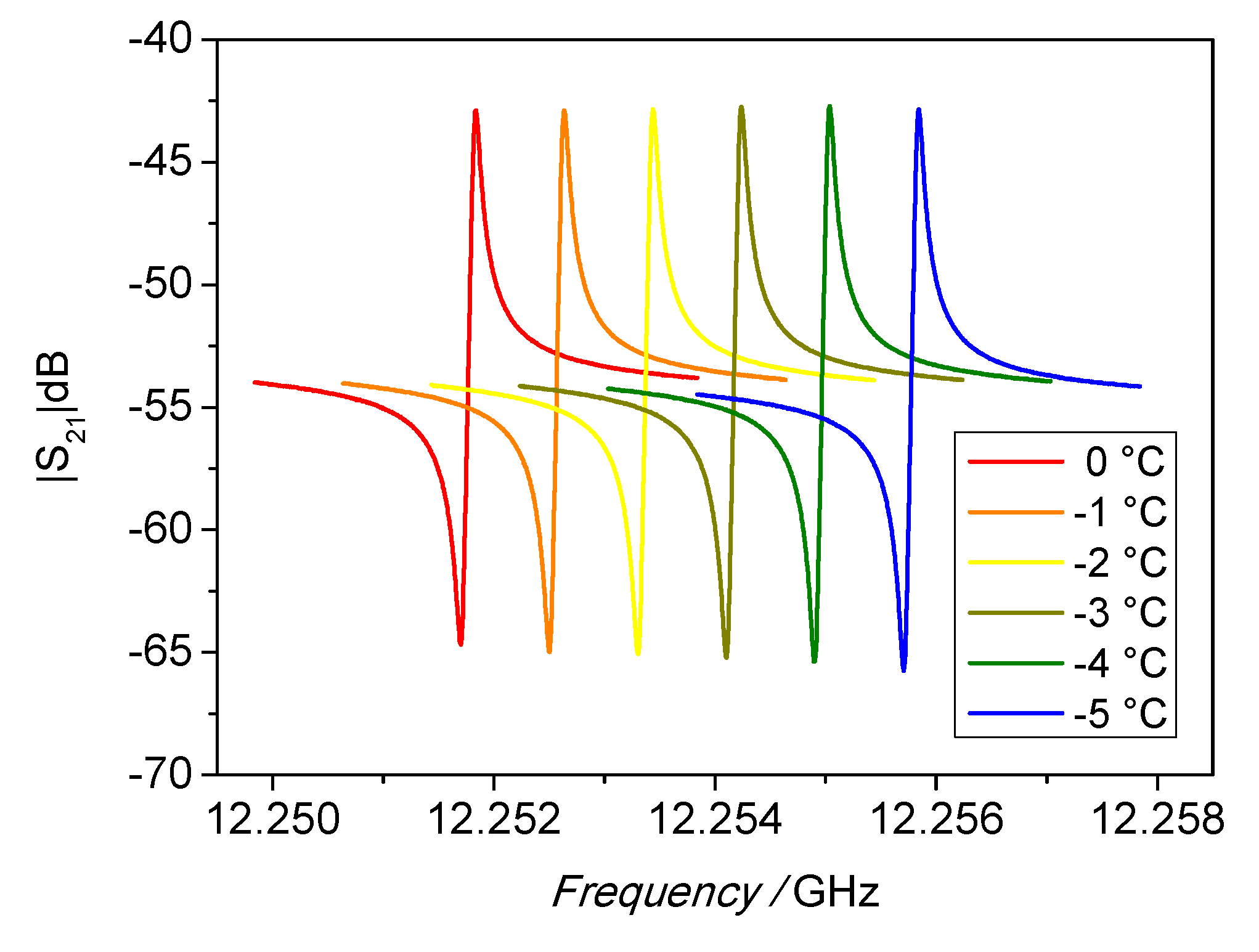
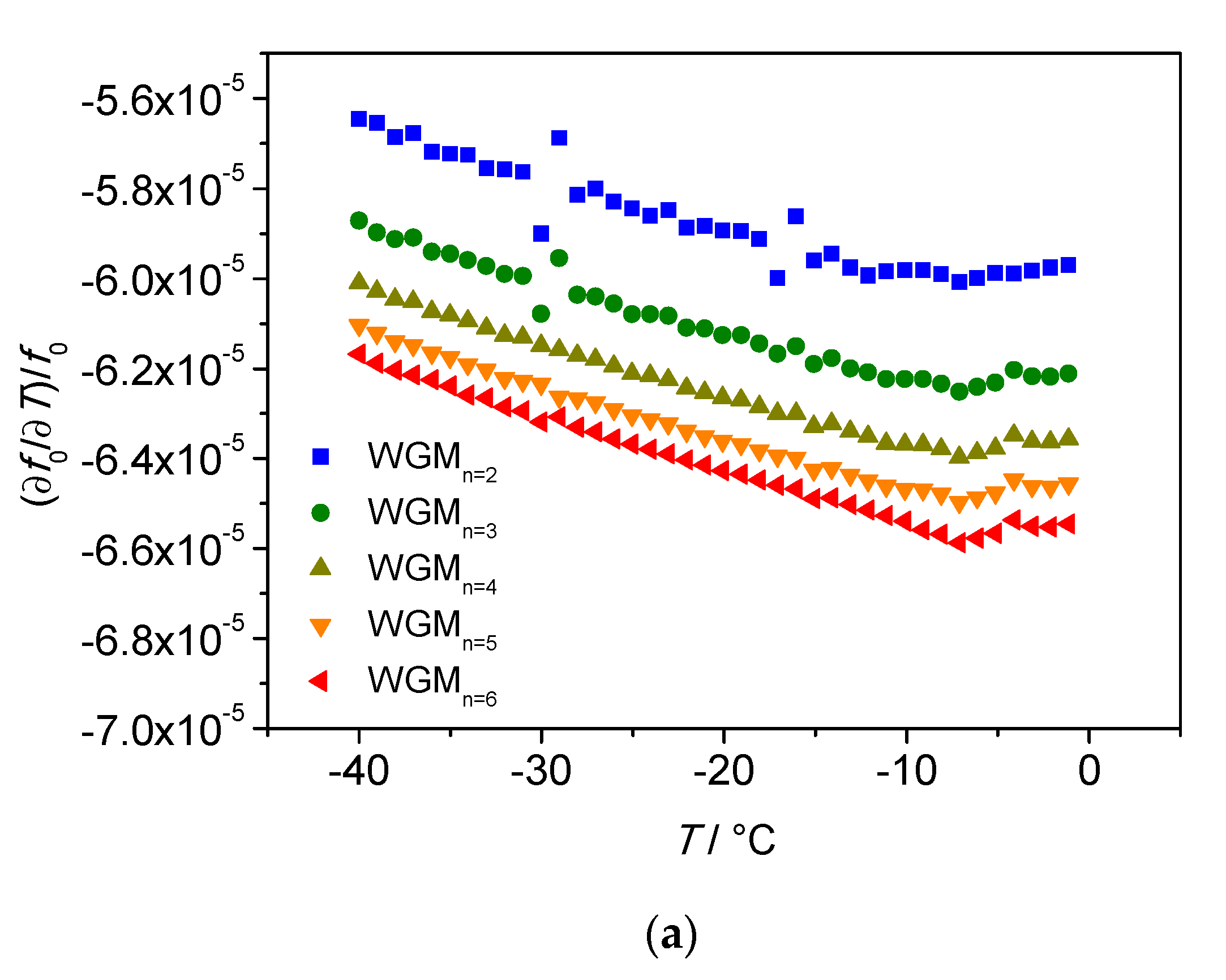

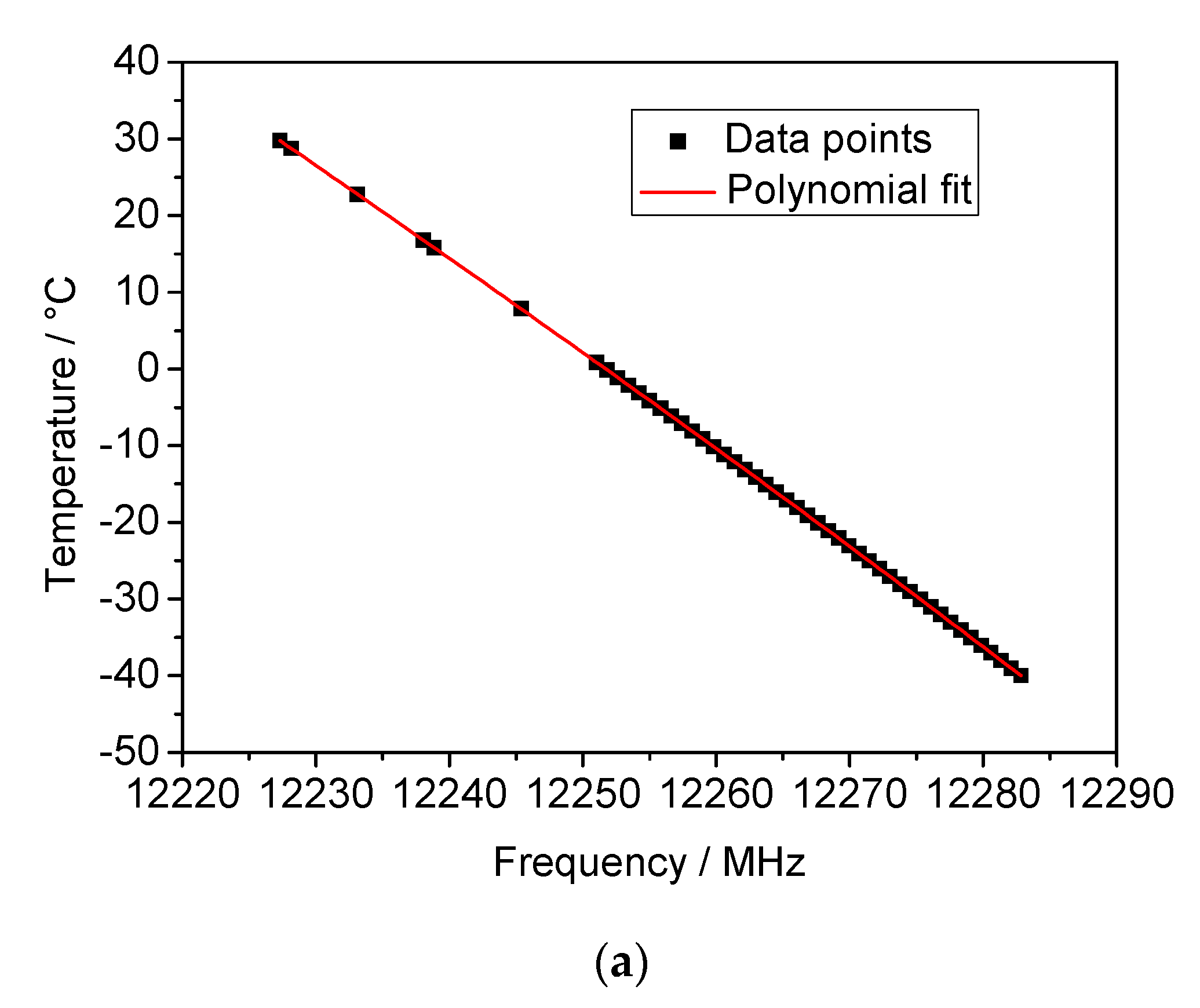
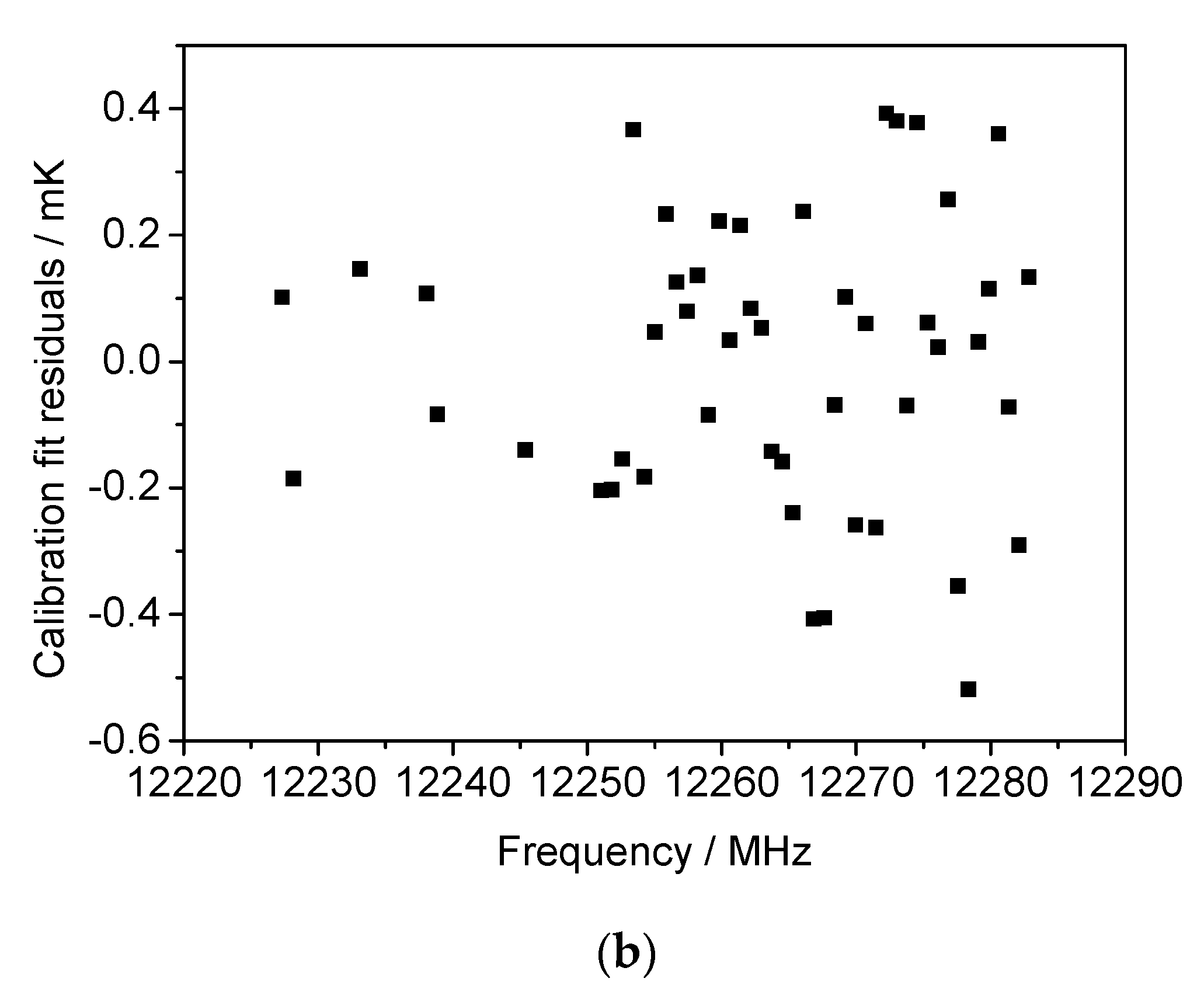
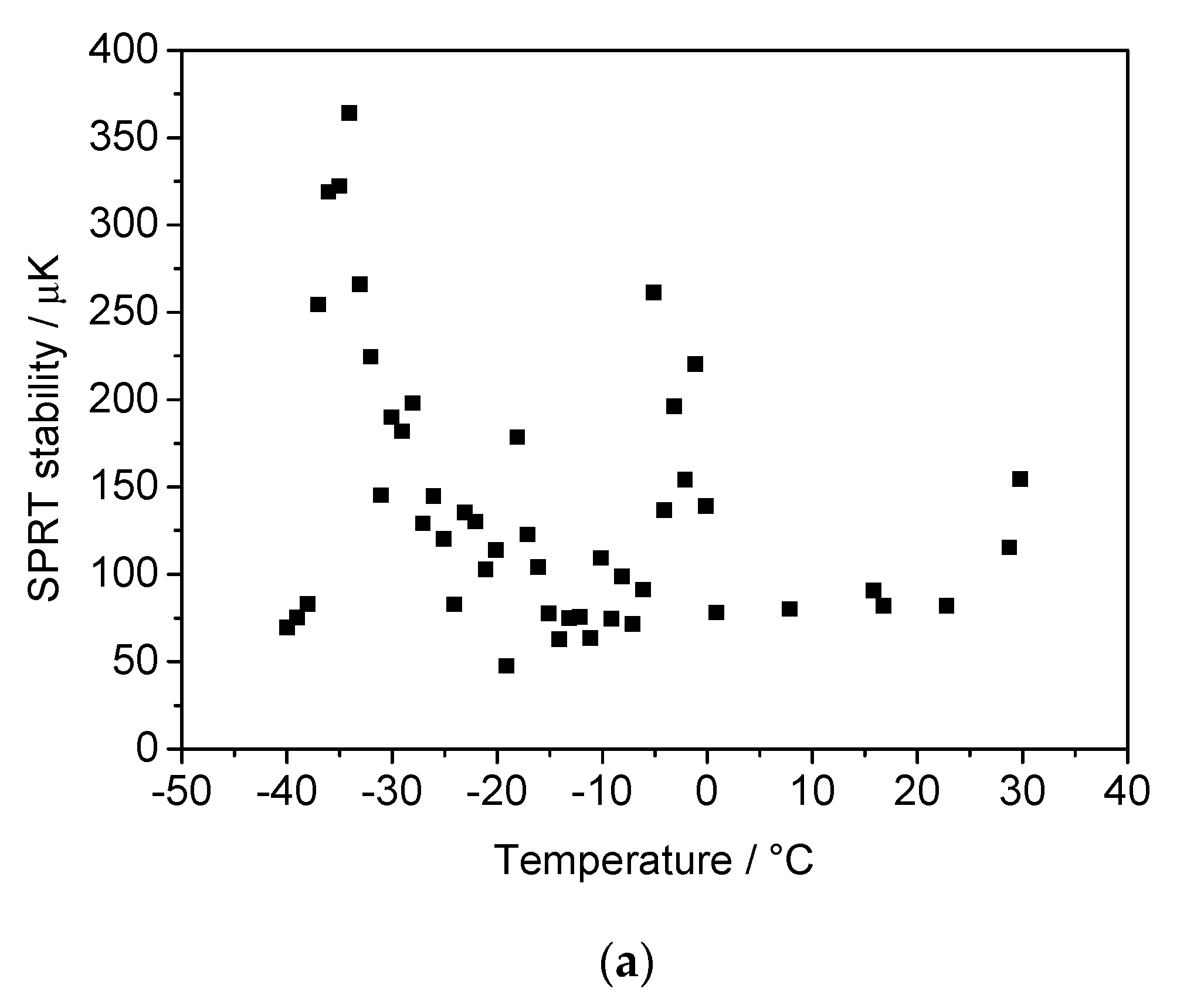

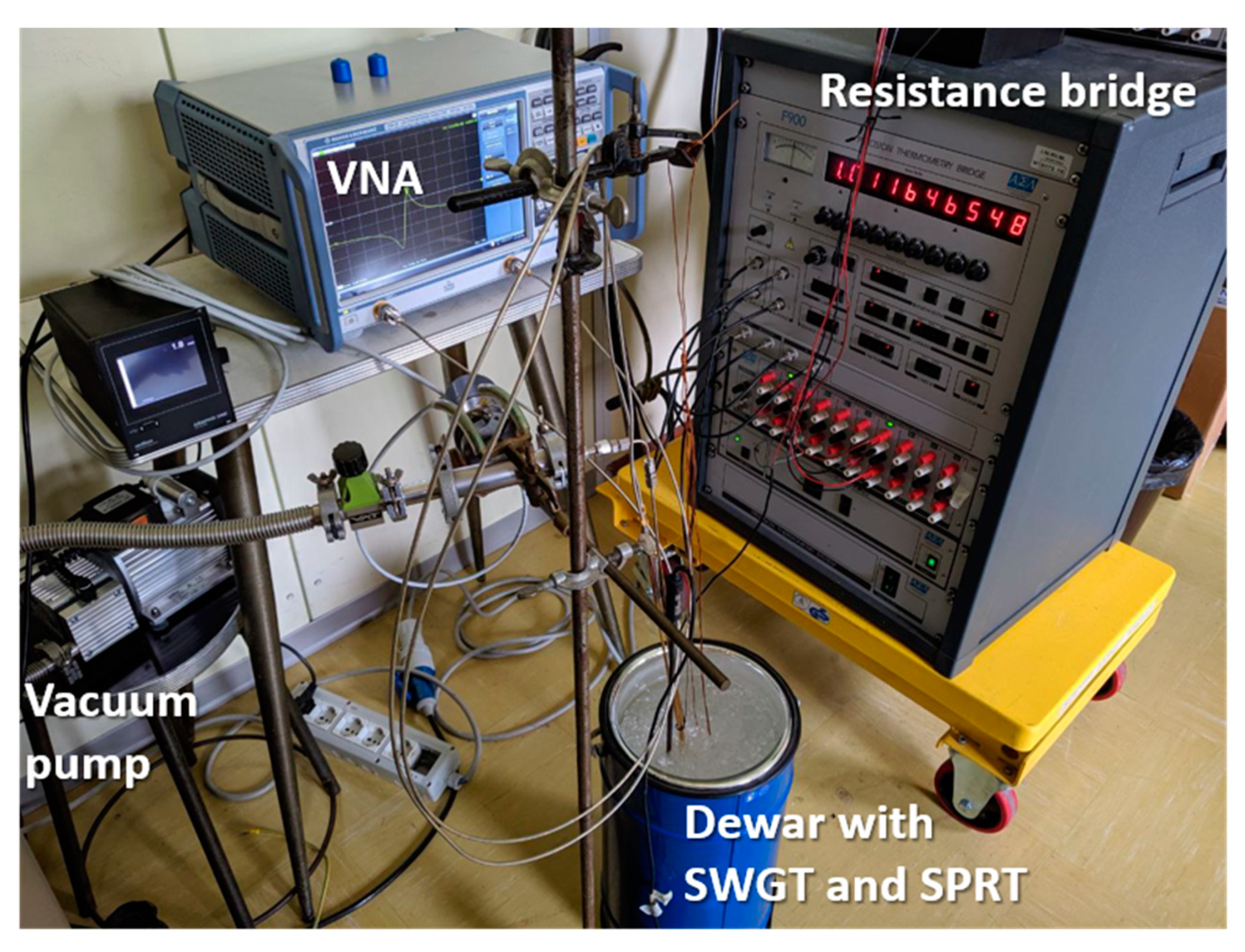
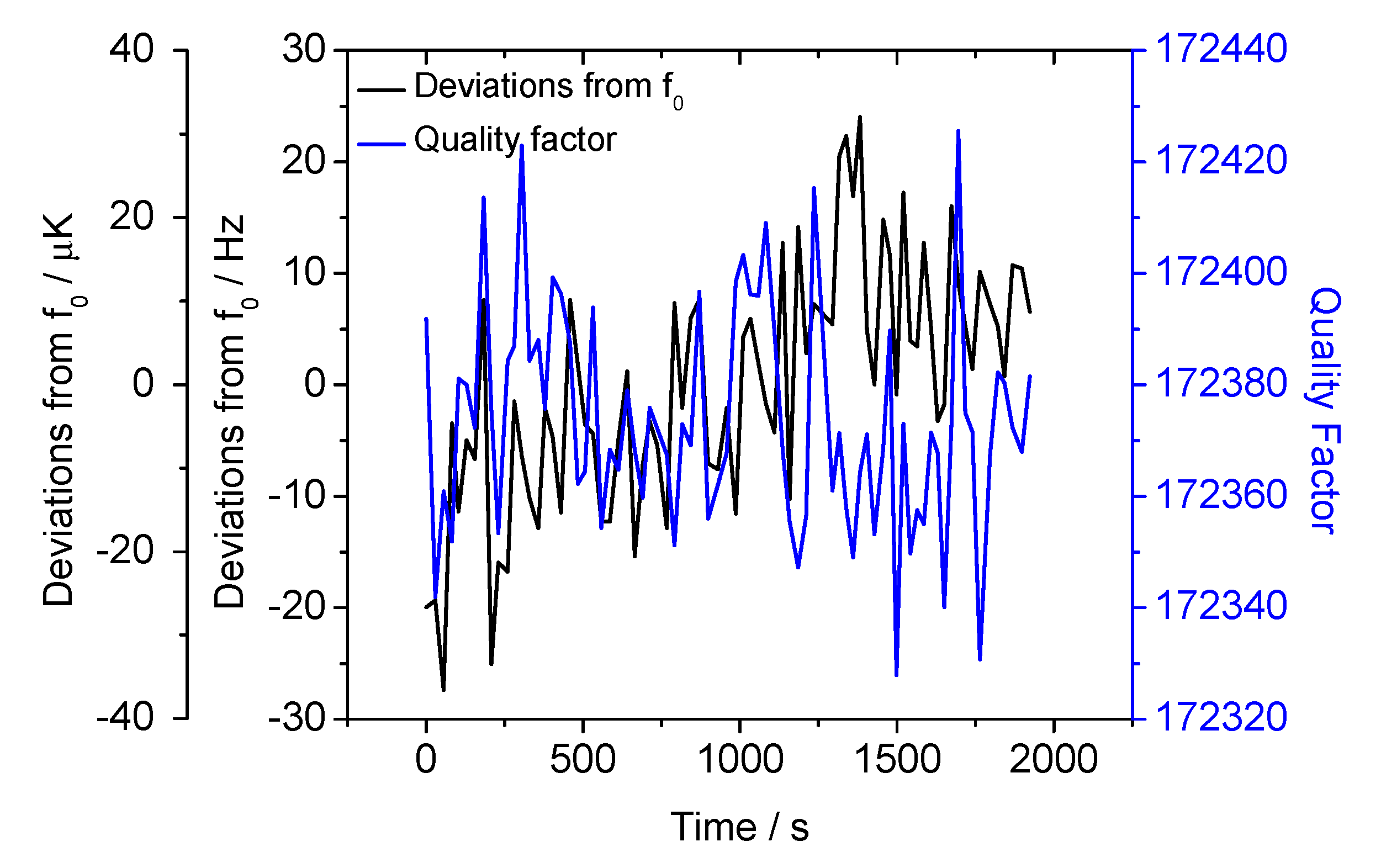
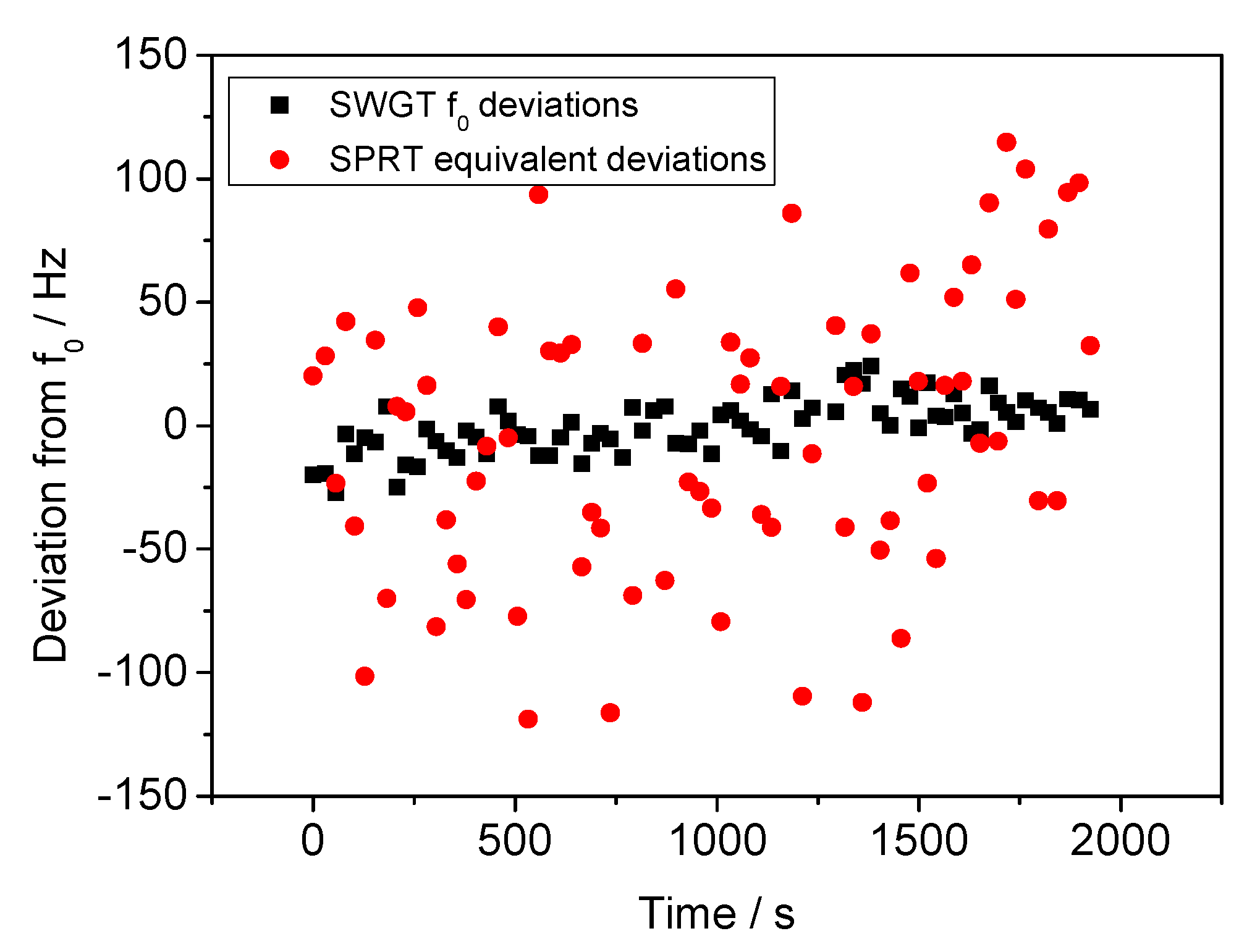
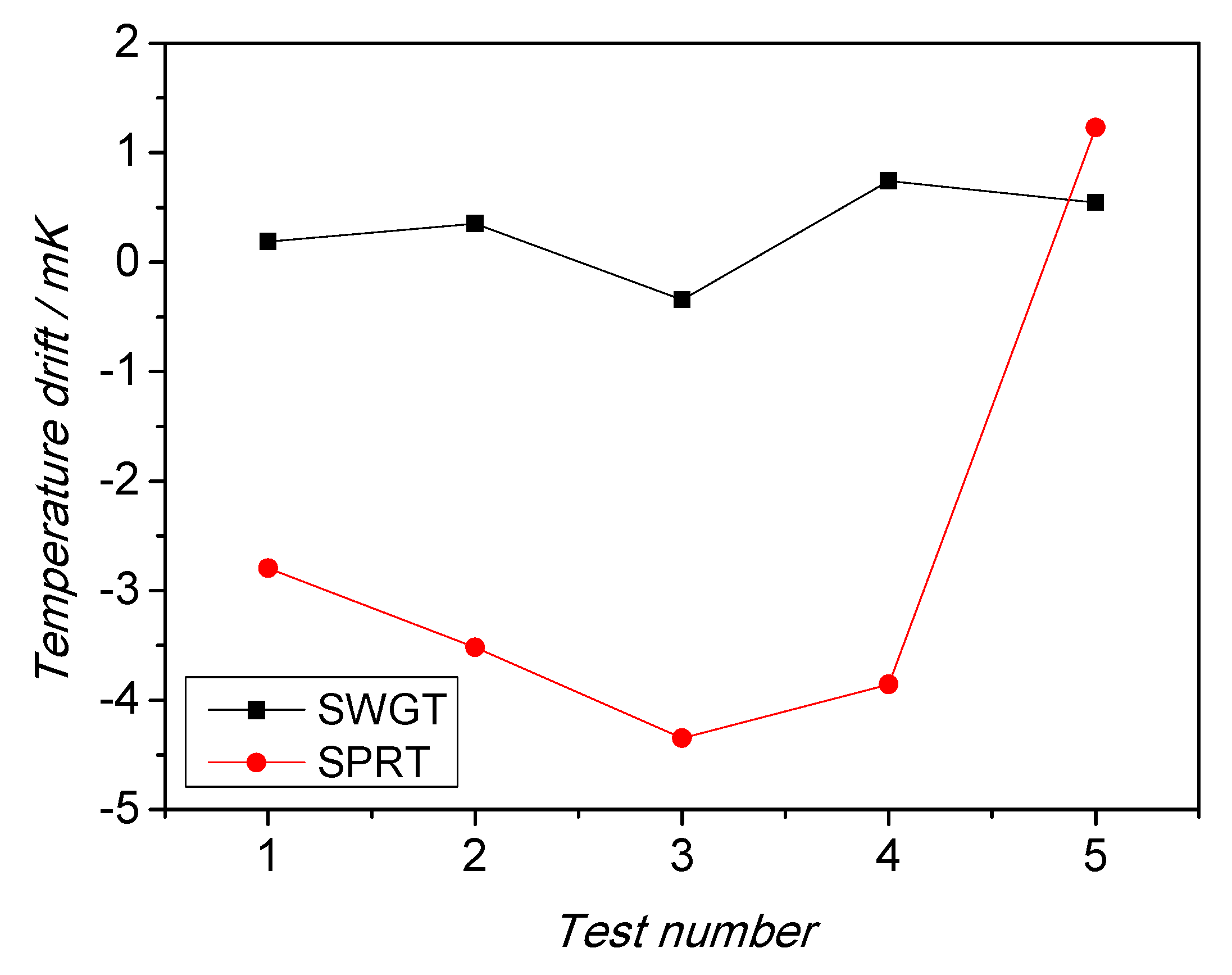
| WGM | f/GHz (sim./Meas.) | Q (sim./Meas.) |
|---|---|---|
| n = 2 | 6.580/6.581 | 88,703/39,690 |
| n = 3 | 8.482/8.487 | 120,890/111,700 |
| n = 4 | 10.375/10.383 | 141,020/158,276 |
| n = 5 | 12.263/12.251 | 152,130/173,442 |
| n = 6 | 14.121/14.105 | 151,945/164,025 |
| Uncertainty Component | Estimate/μK |
|---|---|
| Frequency measurement 1 | 26 |
| SWGT measurement stability | 14 |
| SWGT measurement repeatability | 400 |
| SWGT calibration curve fitting | 200 |
| Thermostatic bath stability | 400 |
| Thermostatic bath uniformity | 1000 |
| SPRT calibration | 300 |
| Thermometry bridge linearity | 10 |
| Uncertainty Component | Estimate/μK |
|---|---|
| Lorentzian fitting reproducibility | 10 |
| VNA accuracy | 5 |
| 10 MHz frequency reference stability | 23 |
| VNA resolution | 5 |
Publisher’s Note: MDPI stays neutral with regard to jurisdictional claims in published maps and institutional affiliations. |
© 2021 by the authors. Licensee MDPI, Basel, Switzerland. This article is an open access article distributed under the terms and conditions of the Creative Commons Attribution (CC BY) license (https://creativecommons.org/licenses/by/4.0/).
Share and Cite
Gugliandolo, G.; Tabandeh, S.; Rosso, L.; Smorgon, D.; Fernicola, V. Whispering Gallery Mode Resonators for Precision Temperature Metrology Applications. Sensors 2021, 21, 2844. https://doi.org/10.3390/s21082844
Gugliandolo G, Tabandeh S, Rosso L, Smorgon D, Fernicola V. Whispering Gallery Mode Resonators for Precision Temperature Metrology Applications. Sensors. 2021; 21(8):2844. https://doi.org/10.3390/s21082844
Chicago/Turabian StyleGugliandolo, Giovanni, Shahin Tabandeh, Lucia Rosso, Denis Smorgon, and Vito Fernicola. 2021. "Whispering Gallery Mode Resonators for Precision Temperature Metrology Applications" Sensors 21, no. 8: 2844. https://doi.org/10.3390/s21082844






